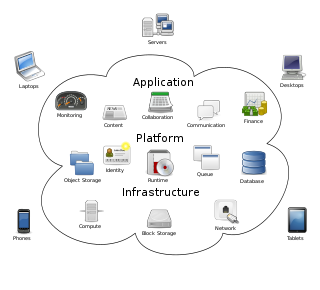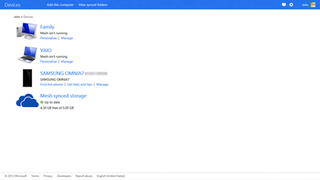NetApp, Inc. is an American data infrastructure company that provides unified data storage, integrated data services, and cloud operations (CloudOps) solutions to enterprise customers. The company is based in San Jose, California. It has ranked in the Fortune 500 from 2012 to 2021. Founded in 1992 with an initial public offering in 1995, NetApp offers cloud data services for management of applications and data both online and physically.

Windows Live Mesh is a discontinued free-to-use Internet-based file synchronization application by Microsoft designed to allow files and folders between two or more computers to be in sync with each other on Windows and Mac OS X computers or the Web via SkyDrive. Windows Live Mesh also enabled remote desktop access via the Internet.

SugarSync is a cloud service that enables active synchronization of files across computers and other devices for file backup, access, syncing, and sharing from a variety of operating systems, such as Android, iOS, Mac OS X, and Windows devices. For Linux, only a discontinued unofficial third-party client is available.
Cloud storage is a model of computer data storage in which data, said to be on "the cloud", is stored remotely in logical pools and is accessible to users over a network, typically the Internet. The physical storage spans multiple servers, and the physical environment is typically owned and managed by a cloud computing provider. These cloud storage providers are responsible for keeping the data available and accessible, and the physical environment secured, protected, and running. People and organizations buy or lease storage capacity from the providers to store user, organization, or application data.

MediaFire is a file hosting, file synchronization, and cloud storage service based in Shenandoah, Texas, United States. Founded in June 2006 by Derek Labian and Tom Langridge, the company provides client software for Microsoft Windows, macOS, Linux, Android, iOS, BlackBerry 10, and web browsers. MediaFire has 43 million registered users and attracted 1.3 billion unique visitors to its domains in 2012.
This is a comparison of online backup services.

Cloud computing is the on-demand availability of computer system resources, especially data storage and computing power, without direct active management by the user. Large clouds often have functions distributed over multiple locations, each of which is a data center. Cloud computing relies on sharing of resources to achieve coherence and typically uses a pay-as-you-go model, which can help in reducing capital expenses but may also lead to unexpected operating expenses for users.
Jungle Disk is both the name of an online backup software service and a privately held data security company. It was one of the first backup services to use cloud storage and Amazon S3. In 2009 after being acquired by Rackspace the service added Rackspace Cloud Files. The name is a word association as the Amazon rainforest is a Jungle and Disk is a common shorthand for a hard disk drive.

GoodSync is a backup and file synchronization program. It is used for synchronizing files between two directories, either on one computer, or between a computer and another storage device or between a computer and a remote computer or server.

Windows Live Devices was an online device management service as part of Windows Live which will allow users to centrally access and manage the synchronization of files stored on their computers, mobile devices, as well as other peripherals such as digital photo frames. Windows Live Devices also allows users to remotely access their computers from the internet using a web browser.

ZumoDrive is a defunct cloud-based file hosting service operated by Zecter, Inc. On December 22, 2010, Zecter announced its acquisition by Motorola Mobility. The service enabled users to store and sync files online, and also between computers using their HybridCloud storage solution; the latter functionality stopped working in approximately September 2011, while the former was undergoing formal takedown on May 1, 2012. ZumoDrive had a cross-platform client that enabled users to copy any file or folder into the ZumoDrive virtual disk that was then synced to the web and the users' other computers and hand-held devices. Files in the ZumoDrive virtual disk could be shared with other ZumoDrive users or accessed from the web. Users could also upload files manually through a web browser interface. A free ZumoDrive account offered 2 GB of storage, and users could upgrade to paid plans ranging from 10 GB to 500 GB for a monthly subscription fee. The ZumoDrive service was integrated into Yahoo! Mail, allowing users to send or receive any file on their ZumoDrive, and powers HP's recent CloudDrive technology, bundled on all new HP Mini netbooks.
This is a list of file synchronization software for which there are Wikipedia articles.

CTERA Networks is a privately held enterprise software company headquartered in New York and Israel. The company has regional offices in the UK, Italy, France, Spain, Germany, and Australia. As of 2021, the company is designated as the leading vendor in distributed cloud file storage by GigaOm.
Google Drive is a file-hosting service and synchronization service developed by Google. Launched on April 24, 2012, Google Drive allows users to store files in the cloud, synchronize files across devices, and share files. In addition to a web interface, Google Drive offers apps with offline capabilities for Windows and macOS computers, and Android and iOS smartphones and tablets. Google Drive encompasses Google Docs, Google Sheets, and Google Slides, which are a part of the Google Docs Editors office suite that allows collaborative editing of documents, spreadsheets, presentations, drawings, forms, and more. Files created and edited through the Google Docs suite are saved in Google Drive.

HP Cloud was a set of cloud computing services available from Hewlett-Packard. It was the combination of the previous HP Converged Cloud business unit and HP Cloud Services, an OpenStack-based public cloud. It was marketed to enterprise organizations to combine public cloud services with internal IT resources to create hybrid clouds, or a mix of private and public cloud environments, from around 2011 to 2016.
A personal cloud is a collection of digital content and services that are accessible from any device through the Internet. It is not a tangible entity, but a place that gives users the ability to store, synchronize, stream and share content on a relative core, moving from one platform, screen and location to another. Created on connected services and applications, it reflects and sets consumer expectations for how next-generation computing services will work.
Enterprise file synchronization and sharing refers to software services that enable organizations to securely synchronize and share documents, photos, videos and files from multiple devices with employees, and external customers and partners. Organizations often adopt these technologies to prevent employees from using consumer-based file sharing apps to store, access and manage corporate data that is outside of the IT department’s control and visibility.

Pydio Cells, previously known as just Pydio and formerly known as AjaXplorer, is an open-source file-sharing and synchronisation software that runs on the user's own server or in the cloud.

MSP360, formerly CloudBerry Lab, is a software and application service provider company that develops online backup, remote desktop and file management products integrated with more than 20 cloud storage providers.
DryvIQ is a software application that enables businesses to migrate on-site system files and associated data across storage and content management platforms, as well as create synchronized hybrid storage systems.











